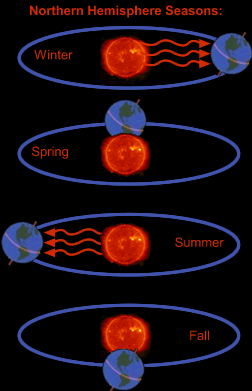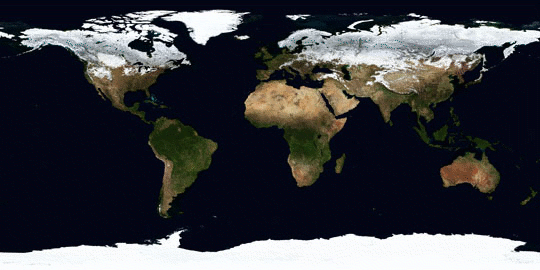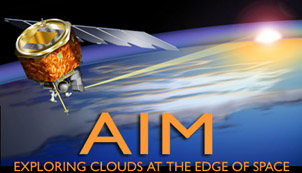Click on image for full size
Windows to the Universe original image
Earth's Tilt Is the Reason for the Seasons!
The Earth travels around the Sun one full time per year. During the year, the seasons change depending on the amount of sunlight reaching parts of the Earth.
The seasons are caused because the Earth is tilted 23.5 degrees on its axis. Summer happens to the hemisphere tilted towards the Sun, and winter happens to the hemisphere tilted away from the Sun. The hemisphere that is tilted towards the Sun is warmer because sunlight travels more directly to the Earth’s surface so less gets scattered in the atmosphere. That means that when it is summer in the Northern Hemisphere, it is winter in the Southern Hemisphere. The hemisphere experiencing summer, tilted towards the Sun, has longer days and shorter nights than the hemisphere tilted away from the Sun.
- On June 21st, the Northern Hemisphere is having its summer solstice because it is tilted towards the Sun receiving the most direct sunlight of the year during the longest day. The Southern Hemisphere is having its winter solstice, the shortest day of the year, because it is tilted away from the Sun.
- On December 21st, the Southern Hemisphere is tilted towards the Sun receiving the most direct sunlight of the year during the longest day. The Northern Hemisphere is having its winter solistice, tipped away from the Sun, producing the shortest day of the year and a low Sun angle.
In general, summer and winter temperatures get lower the further you travel from the equator. At the equator, there are no seasons because each day the Sun strikes at about the same angle. Every day of the year the equator receives about 12 hours of sunlight. The poles remain cool because they are never tilted in the direct path of the sunlight. Light must travel through so much atmosphere that much of it is scattered before reaching the Earth surface. During midwinter, when a pole is tilted away from the Sun, there is no daylight at all at the pole. The Sun never rises. However, during the summer, a pole receives sunlight all the time and there is no night!















